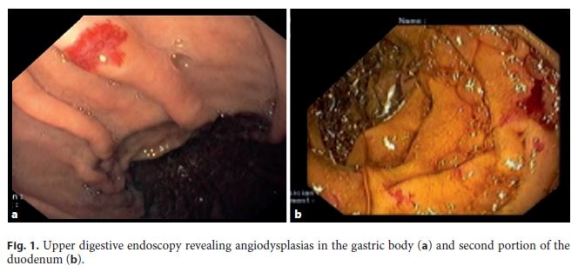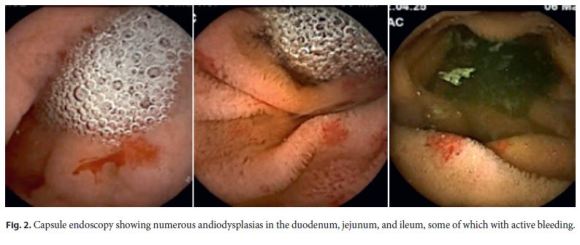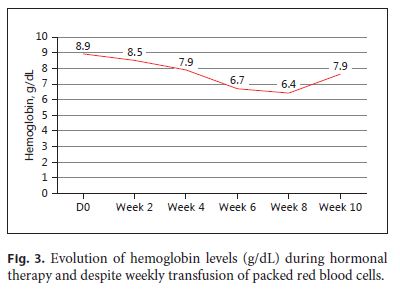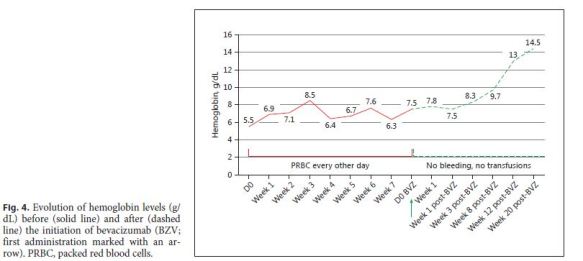Serviços Personalizados
Journal
Artigo
Indicadores
-
 Citado por SciELO
Citado por SciELO -
 Acessos
Acessos
Links relacionados
-
 Similares em
SciELO
Similares em
SciELO
Compartilhar
GE-Portuguese Journal of Gastroenterology
versão impressa ISSN 2341-4545
GE Port J Gastroenterol vol.25 no.2 Lisboa abr. 2018
https://doi.org/10.1159/000481289
CLINICAL CASE STUDY
Bevacizumab for Refractory Gastrointestinal Bleeding in Rendu-Osler-Weber Disease
Bevacizumab para a hemorragia gastrointestinal refractária na doença de Rendu-Osler-Weber
Carlos Bernardes, Sara Santos, Rafaela Loureiro, Verónica Borges, Gonçalo Ramos
Gastroenterology Department, Centro Hospitalar de Lisboa Central, Lisbon, Portugal
* Corresponding author.
ABSTRACT
Rendu-Osler-Weber disease, also known as hereditary hemorrhagic telangiectasia, is a rare autosomal dominant disorder which is often characterized by recurrent epistaxis, mucocutaneous and gastrointestinal telangiectasias, and visceral arteriovenous malformations. Patients with gastrointestinal involvement can present with a wide spectrum of severity, which may vary from uncomplicated iron deficiency anemia to continuous and refractory bleeding. We present the case of a 62-year-old female, who was admitted with anemia following several episodes of melena, and whose endoscopic examination revealed multiple angiodysplasias in the stomach and small bowel. Despite endoscopic and medical treatment attempts with hormonal agents and octreotide, she developed persistent hemorrhage and severe anemia, requiring frequent red blood cell transfusions. Immediately after initiating bevacizumab (7.5 mg/kg, every 3 weeks), complete cessation of bleeding episodes was observed. Currently, after 1 year of follow-up, she maintained sustained remission without the occurrence of adverse events.
Keywords: Bevacizumab, Rendu-Osler-Weber disease, Hereditary hemorrhagic telangiectasia, Telangiectasias, Angiodysplasias, Gastrointestinal bleeding
RESUMO
A doença de Rendu-Osler-Weber, também conhecida por telangiectasia hemorrágica hereditária, é uma doença autossómica dominante rara, frequentemente caracterizada por epistáxis recorrente, telangiectasias mucocutâneas e gastrointestinais e malformações arteriovenosas viscerais. Doentes com envolvimento gastrointestinal podem apresentar um amplo espectro de gravidade, que pode variar de anemia ferropénica não complicada até hemorragia persistente e refractária. Os autores apresentam o caso de uma mulher de 62 anos, admitida por anemia na sequência de vários episódios de melenas, cuja avaliação endoscópica revelou múltiplas angiodisplasias no estômago e intestino delgado. Apesar de várias tentativas de terapêutica endoscópica e médica com agentes hormonais e octreotido, evoluiu para hemorragia persistente e anemia grave, com necessidade de suporte transfusional frequente. Imediatamente após ter iniciado bevacizumab (7,5 mg/kg, a cada 3 semanas) ocorreu cessação total dos episódios de hemorragia. Actualmente, após um ano de follow-up, mantém remissão sustentada sem a ocorrência de quaisquer eventos adversos.
Palavras-Chave: Bevacizumab, doença de Rendu-Osler-Weber,·telangiectasia hemorrágica hereditária, telangiectasias,·angiodisplasias, hemorragia gastrointestinal
Introduction
Rendu-Osler-Weber disease (ROW; also known as hereditary hemorrhagic telangiectasia) is an autosomal dominant disorder which affects approximately 1 in 5,000–8,000 individuals [1]. This entity is characterized by recurrent spontaneous epistaxis, multiple mucocutaneous and gastrointestinal telangiectasias, visceral arteriovenous malformations, and familial history, features that are included in the Curaçao diagnostic criteria [2, 3]. Gastrointestinal involvement usually arises after the 5th or 6th decade of life and its management may be particularly challenging [4]. We present the case of a female patient, diagnosed with ROW 10 years earlier, who developed severe and persistent bleeding from gastrointestinal angiodysplasias. Despite having been submitted to endoscopic treatment with argon plasma coagulation (APC), hormonal therapy, and octreotide, she kept having continuous blood loss and significant transfusion requirements. Bevacizumab was started and followed by a dramatic and sustained clinical and biochemical response.
Clinical Case
A 62-year-old female was diagnosed with ROW at the age of 52 due to recurrent epistaxis, multiple mucocutaneous telangiectasias, and a positive family history. Ten years after the diagnosis, she presented to the emergency department with a recent history of fatigue, dizziness, and several episodes of melena. Laboratory studies revealed microcytic anemia (hemoglobin 4.5 g/dL, median corpuscular volume 69 fL), with low transferrin saturation (9%) and ferritin (4.1 ng/mL). She underwent an upper digestive endoscopy which described a few angiodysplasias in the gastric body and duodenum; APC was performed (Fig. 1). Since the number of gastroduodenal vascular lesions appeared to be insufficient to justify the degree of bleeding, a capsule endoscopy was performed, revealing multiple (more than 100) angiodysplasias in the duodenum, jejunum, and ileum (Fig. 2). Further investigation, which included colonoscopy, abdominal ultrasound, thoracic CT, and cranial MRI scans, detected no additional vascular abnormalities. Despite having been submitted to coagulation of several vascular lesions through double-balloon enteroscopy and having initiated hormonal therapy with ethinylestradiol plus norethisterone (2 + 1 mg per day), hemorrhage and anemia persisted with the need for repeated transfusion of packed red blood cells (PRBC) (Fig. 3). Treatment with octreotide was started; however, a few hours after the first subcutaneous administration (100 μg), the patient presented with abdominal discomfort, nausea, and vomiting, leading to the discontinuation of the treatment. Given the maintenance of severe gastrointestinal bleeding, with PRBC transfusion dependence (1 unit every other day to ensure levels of 6–7 g/dL of hemoglobin), systemic therapy with bevacizumab was introduced at a dose of 7.5 mg/kg, intravenously, every 3 weeks. The patients clinical response was immediate: since the beginning of the therapy, she had not required any transfusion support and only had one episode of melena when an infusion was postponed for 1 week due to an upper respiratory infection (Fig. 4). After 6 weeks of treatment, the regimen was adjusted to 5 mg/kg every 3 weeks, without any change in clinical status. Currently, after 1 year of follow-up, she maintained complete clinical and biochemical remission without any adverse event.




Discussion
Gastrointestinal involvement, the second most frequent cause of bleeding in ROW patients, occurs in about one third of subjects with this condition [5]. Of those, approximately one half may develop significant disease and need regular blood transfusions [6]. The stomach and the duodenum are the most commonly affected organs [7]; notwithstanding, small bowel angiodysplasias may be found in 56–89% of the cases [8, 9]. Although endoscopic treatment with APC may be useful for patients who do not achieve control with initial general supportive measures, the use of multiple endoscopic procedures in patients with continuous blood loss is not recommended [4]. For patients like ours, presenting with refractory bleeding and consequent severe anemia, several therapeutic possibilities were described to treat vascular lesions [10]. Hormonal therapy with an estrogen-progesterone combination proved to be beneficial in a small controlled study of 9 patients, 5 of which had ROW [11]. Nonetheless, the biggest randomized controlled trial regarding this medical option failed to show a decrease in the number of bleeding episodes and transfusion requirements in noncirrhotic subjects with gastrointestinal telangiectasias [12]. Although there are no comparative studies between them, both thalidomide and octreotide long-acting release were reported to be safe and effective for patients with gastrointestinal hemorrhage [13–16]; the latter has even reduced hospital admissions and demonstrated a cost-effective benefit in this setting [15, 16]. In spite of being a generally safe drug, adverse events such as nausea, diarrhea, and flatulence are relatively common within the first hours following administration of octreotide [14]. Although these symptoms usually resolve after the first weeks, their occurrence may represent an additional challenge. In this case, as the patient developed gastrointestinal symptoms after the first administration of octreotide, she refused further treatment with this drug and we were not able to introduce the long-acting release formulation. Therefore, given the behavior of her disease and her intolerance to octreotide, we decided to initiate bevacizumab. This recombinant humanized monoclonal antibody is directed against the vascular endothelial growth factor, a protein which plays a critical role in the pathophysiology of ROW [17]. In addition to having been successfully applied in the management of epistaxis and in thereduction of high cardiac output in patients with severe hepatic involvement [18], bevacizumab was shown to be effective controlling gastrointestinal bleeding in a few case reports [19–23]. In fact, patients who were refractory to several other medical and endoscopic approaches, and whose transfusion requirements ranged from 1 unit of PRBC every week to about 300 units in a year, all were reported to have developed a significant decrease in bleeding episodes and transfusion needs [19–23]. Furthermore, as in our case, authors described an extremely quick and long-term response, as well as the occurrence of early relapse following drug discontinuation [19–21]. Epperla et al. [21] published a case series comprising 5 ROW patients (4 with epistaxis and only 1 with gastrointestinal hemorrhage) who have reduced their PRBC consumption by 51–100% and their total number of emergency department visits and hospitalizations by 78%. Of note, hypertension and proteinuria were observed in 2 and 1 of those patients, respectively, during the follow-up period [21]. The optimal dose and regimen for this agent are not fully established yet. Although the majority of authors used 5 or 7.5 mg/kg every 2 or 3 weeks, successful use of low-dose bevacizumab (1 or 2 mg/kg, every 3 weeks) was already reported, which could potentially decrease drug-related costs and adverse events [22, 23]. In our patient, in whom hormonal therapy did not achieve clinical remission and who did not tolerate octreotide, intravenous bevazicumab at a dose of 5 mg/kg every 3 weeks was able to attain a dramatic and sustained response, without any complication. This case reinforces that this agent may be extremely useful for subjects who are either intolerant or refractory to alternative treatment options.
References
1 Dakeishi M, Shioya T, Wada Y, et al: Genetic epidemiology of hereditary hemorrhagic telangiectasia in a local community in the northern part of Japan. Hum Mut 2002;19:140–148. [ Links ]
2 Shovlin CL: Hereditary haemorrhagic telangiectasia: pathophysiology, diagnosis and treatment. Blood Rev 2010;24:203–219. [ Links ]
3 Shovlin CL, Guttmacher AE, Buscarini E, et al: Diagnostic criteria for hereditary hemorrhagic telangiectasia (Rendu-Osler-Weber syndrome). Am J Med Genet 2000;91:66–67. [ Links ]
4 Faughnan ME, Palda VA, Garcia-Tsao G, et al: International guidelines for the diagnosis and management of hereditary haemorrhagic telangiectasia. J Med Genet 2011;48:73–87. [ Links ]
5 Vase P, Grove O: Gastrointestinal lesions in hereditary hemorrhagic telangiectasia. Gastroenterology 1986;91:1079–1083. [ Links ]
6 Porteous ME, Burn J, Proctor SJ: Hereditary haemorrhagic telangiectasia: a clinical analysis. J Med Genet 1992;29:527–530. [ Links ]
7 Kjeldsen AD, Kjeldsen J: Gastrointestinal bleeding in patients with hereditary hemorrhagic telangiectasia. Am J Gastroenterol 2000;95:415–418. [ Links ]
8 Ingrosso M, Sabbà C, Pisani A, et al: Evidence of small-bowel involvement in hereditary hemorrhagic telangiectasia: a capsule-endoscopic study. Endoscopy 2004;36:1074–1079. [ Links ]
9 Proctor DD, Henderson KJ, Dziura JD, et al: Enteroscopic evaluation of the gastrointestinal tract in symptomatic patients with hereditary hemorrhagic telangiectasia. J Clin Gastroenterol 2005;39:115–119. [ Links ]
10 Jackson CS, Strong R: Gastrointestinal angiodysplasia: diagnosis and management. Gastrointest Endosc Clin N Am 2017;27:51–62. [ Links ]
11 van Cutsem E, Rutgeerts P, Vantrappen G: Treatment of bleeding gastrointestinal vascular malformations with oestrogen-progesterone. Lancet 1990;335:953–955. [ Links ]
12 Junquera F, Feu F, Papo M, et al: A multicenter, randomized, clinical trial of hormonal therapy in the prevention of rebleeding from gastrointestinal angiodysplasia. Gastroenterology 2001;121:1073–1079. [ Links ]
13 Ge ZZ, Chen HM, Gao YJ, et al: Efficacy of thalidomide for refractory gastrointestinal bleeding from vascular malformation. Gastroenterology 2011;141:1629–1637.e1–4. [ Links ]
14 Nardone G, Compare D, Scarpignato C, et al: Long acting release-octreotide as rescue therapy to control angiodysplasia bleeding: a retrospective study of 98 cases. Dig Liver Dis 2014;46:688–694. [ Links ]
15 Salgueiro P, Marcos-Pinto R, Liberal R, et al: Octreotide long-acting release is effective in preventing gastrointestinal bleeding due to angiodysplasia. GE Port J Gastroenterol 2014;21:176–183. [ Links ]
16 Klímová K, Padilla-Suárez C, Giménez-Manzorro A, et al: Octreotide long-active release in the treatment of gastrointestinal bleeding due to vascular malformations: cost-effectiveness study. Rev Esp Enferm Dig 2015;107:79– 88. [ Links ]
17 Kanellopoulou T, Alexopoulou A: Bevacizumab in the treatment of hereditary hemorrhagic telangiectasia. Expert Opin Biol Ther 2013;13:1315–1323. [ Links ]
18 Dupuis-Girod S, Ginon I, Saurin JC, et al: Bevacizumab in patients with hereditary hemorrhagic telangiectasia and severe hepatic vascular malformations and high cardiac output. JAMA 2012;307:948–955. [ Links ]
19 Ou G, Galorport C, Enns R: Bevacizumab and gastrointestinal bleeding in hereditary hemorrhagic telangiectasia. World J Gastrointest Surg 2016;8:792–795. [ Links ]
20 Lupu A, Stefanescu C, Treton X, et al: Bevacizumab as rescue treatment for severe recurrent gastrointestinal bleeding in hereditary hemorrhagic telangiectasia. J Clin Gastroenterol 2013;47:256–257. [ Links ]
21 Epperla N, Kapke JT, Karafin M, et al: Effect of systemic bevacizumab in severe hereditary hemorrhagic telangiectasia associated with bleeding. Am J Hematol 2016;91:E313–E314. [ Links ]
22 Lazaraki G, Akriviadis E, Pilpilidis I, et al: Low dose of bevacizumab is safe and effective in preventing bleeding episodes in hereditary hemorrhagic telangiectasia. Am J Gastroenterol 2011;106:2204–2206. [ Links ]
23 Wee JW, Jeon YW, Eun JY, et al: Hereditary hemorrhagic telangiectasia treated with low dose intravenous bevacizumab. Blood Res 2014;49:192–195. [ Links ]
Statement of Ethics
This study did not require informed consent nor review/approval by the appropriate ethics committee.
Disclosure Statement
The authors have no conflicts of interest to declare.
* Corresponding author.
Dr. Carlos Bernardes
Rua Alfredo Inácio Ramos da Silva, 28, 3° E.
PT–2730-203 Barcarena (Portugal)
E-Mail carlosfbernardes@gmail.com
Received: August 1, 2017; Accepted after revision: August 31, 2017














